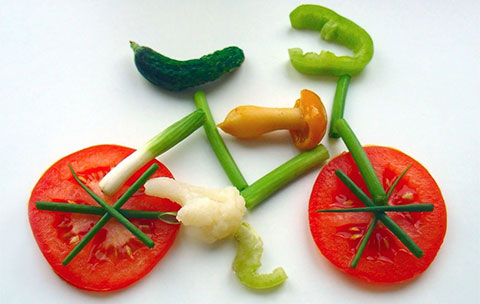Your Guide to Good Nutrition

PROTEIN
Every body cell needs an adequate supply of protein for building and maintaining health. Greater amounts of protein are required during growth periods: childhood, adolescence, and pregnancy, when new cells must be formed.
Best sources of complete protein are meat, fish, poultry, eggs, milk, cheese. Vegetable (incomplete) protein is found in soybeans and other legumes, nuts and cereals. Include some protein at each meal to maintain good general health.
CARBOHYDRATES
Starches and sugars are a main fuel source for most people. Some forms of carbohydrates, found in plant fibres, help elimination of wastes in body.
“Worthwhile” carbohydrates (which include other nutrients) are found in fruit, vegetables, cereals and bread; not in syrups, cordials or sweets.
FATS
Fats are the most concentrated supplier of body fuel, add flavor to food, slow down the rate of stomach emptying, lubricate the digestive tract.
Richest sources in “visible” form: edible oil, margarine, butter and fat on meat. Lean meat, egg yolk, nuts, milk and cheese also contain some fat.
CALCIUM
Calcium is needed by people of all ages for good bones and teeth; clotting of blood; functioning of muscles, and it also helps nervous system.
Milk, cheese and fish with edible bones (such as sardines or salmon) are best sources. Calcium in milk is combined with nutrients which favor absorption.
IODINE
Needed for correct functioning of the thyroid gland to prevent goitre and also to regulate energy.
Sea foods are richest suppliers of iodine. Content of iodine present in cereals, vegetables and milk varies in different areas depending on soil content.
IRON
Needed to form haemoglobin in red blood cells, which carry oxygen from lungs to all body tissues.
Found in liver, kidney, hearts, other meat, poultry and egg-yolk. Dried beans, wholemeal bread, green leafy vegetables, molasses, nuts and dried fruits contain smaller quantities of Iron.
SODIUM
Maintains the correct water balance in the body.
Found in poultry, eggs, olives, salt, fish and meat. Helps keep fluid balance; aids muscles and nerves. Fruit, vegetables, fish, meat, cereals are sources.
PHOSPHORUS
Works with calcium to keep bones and teeth strong; also helps fat do its work in the body.
Obtained in milk, cheese, poultry, whole grain cereals; also in fish, nuts, dried beans and peas.
MAGNESIUM
Helps transmit nerve impulses, helps muscle contraction, necessary (as it works with calcium) to promote strong teeth and bones.
Cereals, meats, dried beans, nuts and milk all contain reasonable quantities of magnesium.
VITAMIN A
Needed for growth and development, healthy skin, vision in poor light, helps prevent and resist infection in the mucous membranes.
Found in liver, butter, milk, cheese and egg-yolks. Carotene, found in yellow fruits and green and yellow vegetables, converts to vitamin A in body.
THIAMINE
Essential for use of carbohydrates in the body, and for the correct functioning of nervous system.
Yeast and vegetable extract, pork, nuts, egg-yolks, whole grain cereals, wheat germ, dried beans and peas are all good sources of thiamine vitamin.
RIBOFLAVIN
Essential for metabolism of carbohydrates and protein, also for growth, vigor, good digestion, healthy skin and for maintaining good vision.
Foods rich in this vitamin are milk, cheese, liver, heart, kidney, eggs, wheat germ, yeast and vegetable extracts. Sun can destroy riboflavin.
NIACIN
Required for release of energy in body, for healthy nervous system, skin, and digestive tract.
Found in meat (especially organ meats), fish, peanuts, yeast and vegetable extract, legumes and wholegrain cereals; also in peanut butter.
VITAMIN C
Needed for the formation of a cement-like substance between the cells. Also needed for healthy blood vessels, teeth, bone, and cartilage.
Best sources are citrus fruits, blackcurrants, papaw, rockmelon. tomatoes, red and green peppers, and fresh broccoli and brussel sprouts.
VITAMIN D
Helps body make proper use of calcium and phosphorus in the formation of teeth and bones.
Can be made in the body when skin is exposed to sunlight. Also in salmon, sardines, fish liver oils, and in dairy products and eggs in small amounts.
VITAMIN B6
Assists body to use protein and maintain the normal haemoglobin level in the blood.
Found in meats, wheat germ, liver, wholegrain cereals, kidney; also in soybeans and peanuts.
VITAMIN B12
Produces red blood cells and builds new proteins. Present in fish, cheese, eggs, meat, milk, liver and kidney.
VITAMIN E
Functions not fully understood, but is thought to help form red blood cells, muscle and tissue.
Richest sources are wheat germ oil, cereals, leafy green vegetables, nuts, eggs, and margarine.
Are you looking for healthy meals or dinner ideas? You can easily find the perfect flavour for your dinner together with a bunch of great recipes by checking out The Flavour Generator from hellofresh.com.au.
References:
http://www.lifetips.top/health/7-day-fruit-and-vegetable-diet/
http://www.lifetips.top/health/14-day-500-calorie-diet/